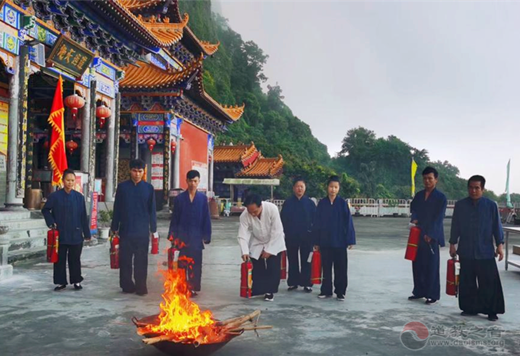世间万象,物情物态,山水之跌宕,四季之更迭,草木之枯荣,日月之盈亏,皆以其自然的生命轨迹而生长。世人琢磨物态,通常会在种种因素的考量下赋予其不同的情感意志,而山水之于中国人,却始终承载着一种典型的东方审美趣味,即根植于道家思想所衍生出的淡泊与逍遥。传统山水画发展至今,尽管在笔墨技法等绘画的本体语言上都有了长足的进步与延伸,却仍旧囿于“传统”的惯性牵引抑或抱有“拿来主义”的惰性心理,无法在山水画的创作过程中打破固有程式,对于画面情感的映射作出质的改变。
秋人的山水创作,便是基于传统绘画中的这一陋习所作出的个体尝试。这种尝试体现在秋人对传统绘画本体语言和画面精神意志的消解与重建之中。早年作为海派大师陆俨少的后学,秋人了悟传统笔墨;八十年代作为圆明园宣言的起草者,秋人深谙先锋艺术。其作品以传统为根基,加上抽象构成,钩斫笔线,氤氲流动,在笔气跌宕之中饶有古意。也许正是在如此的学养背景下,他的创作才能取得今日之成效。
绘画本体语言方面,秋人首先消弱的是传统国画中极为注重的线条书写性,他将直线大胆引入画中,不分粗细,无关节奏,强行而干脆地嫁接在山头、树石、溪涧任何他想见到的地方,活生生将传统绘画中讲求的温润圆转割裂的支离破碎,却又形成了一种似镌刻于山石根处的独特美感。同时他又消解掉皴法对画面形体的支撑,以坚固的几何块面化身为山石,意在营造出厚重的体量感。在云彩的处理上,大量**的加入,使应有的空灵轻逸同样转为厚实凝重,甚至出现了“云比石重”的反常观感,而这种反常观感又在秋人不断赋予其重量的层层叠加中由当下觉醒转向未来指引,呈现出一种穿越历史,来自亘古的真实。
在淡泊与逍遥之间,秋人更注重对自然山水的静观与直觉中觉悟生命,绘画创作仅是其修行的日课而已,所以他的画面往往呈现出的实是关照自我的超现实心象山水。忌讳的天地二色(白色的矿粉和积墨的山头)被强悍执拗地共生于山顶,肃穆的庄严随之弥漫,道家所偏好的素色,也以暗合藏传佛教的经幡色:蓝、白、红、绿、金所替代,绚烂炽热,颇具唐宋的宏大堂皇之气,被赋予“秋人式”独立意志后的山石草木体量夯实,更显坚韧崇高,藏于其间的庙宇僧者便是“我”之投影,于是,秋人便在这样一片澄澈澹然的心境中,明心见性,将感悟自然的山水看成有生命同己的存在,在肃穆的修悟中体察生命的韵律,获得内心的欢喜自在。
Willpower of Mountains and Rivers
by Jia Tingfeng
Every phenomenon on earth, including principles and physical states such as ups and downs of mountains and rivers, cycle of seasons, withering and flourishing of plants, the waxing and waning of the moon, follows its natural orbit of life. For various kinds of reasons, people give different emotions and willpowers to everything on the world. Mountains and rivers, for Chinese people, always carry a typical oriental aesthetic taste, which has been rooted in quietism and freedom of Taoism. So far, the traditional landscape painting has achieved considerable progress and development in the ontology language of painting skill but still is restricted to the inertness of tradition or enslaved to the inertia of “borrowlism”. The existing pattern for creation of landscape painting cannot be broken, so it is difficult to obtain qualitative change in reflection of painting emotion.
Wang Qiuren’s landscape painting is an individual adventure after breaking off the bad custom in traditional painting, which is demonstrated by his dissolution and reconstruction of conventional painting ontology language and picture willpower and spirit. As a follower of Lu Yanshao, a Shanghai-style painting master, in early years, Wang Qiuren has understood and mastered traditional ink painting. In 1980s, he, as one of drafters of “Winter Palace Declaration”, is very familiar with avant-garde art. Based on tradition, he adds abstract expression to imply antique aura in paintings. Maybe, he can make today’s achievement just because of that education background.
As for the painting ontology language, Wang Qiuren firstly weakens line painting to which the traditional Chinese painting attaches great importance and boldly uses straight lines, thick and thin, in his painting without consideration of rhythm. The straight lines are definitely used by Wang Qiuren to mountain top, tree, stone, mountain stream and everywhere he want to see, and the softness and mildness which the conventional painting stresses are completely broken through to create unique aesthetic feeling. In addition, he abandons texturing method in his painting and draws mountain stone with geometric blocks, aiming at creating heavy sense of volume. In painting clouds, he converts the lightness which should have had to heaviness by using a great deal of white powder, which even brings anomalous impression of “heavier cloud than stone”. This anomalous impression switches to future guidance after Wang Qiuren’s constant overlaying and brings a never-ending truth across history.
In the midst of quietism and freedom, Wang Qiuren attaches more importance to reflections on life by quietly appreciating natural landscape and intuition. Painting is just a way of cultivating himself, so his paintings often show surreal landscape in his mind. The two colors of heaven and earth, white and black, which are avoided by people (white mineral powder and black mountain top) are pertinaciously used in drawing mountain tops. The grandeur is filled in the painting and plain colors preferred by Taoist are replaced by gorgeous colors of the prayer flag of Tibetan Buddhism: blue, white, red, green and gold. His painting, with grand style of Tang and Song Dynasties, contains solid expression when the mountain, stone, grass and tress are given “Wang Qiuren-style” independent willpower and become stronger. The Buddhist in the painting is a miniature of “me”. Therefore, Wang Qiuren is cultivating and training his mind in this land of clarity and quietism. He regards natural landscape he sees as his life and experiences the rhythm of life in his cultivation to gain peace and pleasure in mind.
关键字: 内容标签:
如果本站的内容资源对您有所帮助


献给世界,你的真心,以致来世,以致未来











 推荐好文
推荐好文






